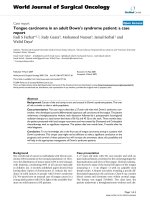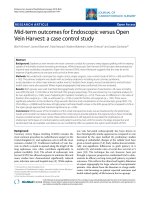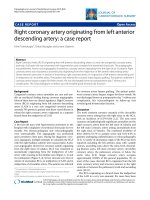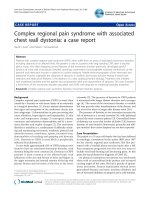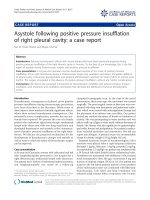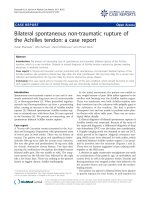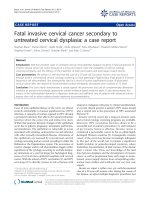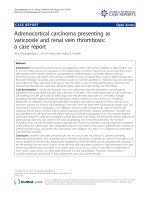Báo cáo y học: "Adrenocortical carcinoma presenting as varicocele and renal vein thrombosis: a case report." ppsx
Bạn đang xem bản rút gọn của tài liệu. Xem và tải ngay bản đầy đủ của tài liệu tại đây (944.77 KB, 5 trang )
CAS E REP O R T Open Access
Adrenocortical carcinoma presenting as
varicocele and renal vein thrombosis:
a case report
Wisit Cheungpasitporn
*
, John M Horne and Charles B Howarth
Abstract
Introduction: Adrenocortical carcinomas are rare aggressive tumors. Their annual incidence is approximately one
to two per million among the population of the United States of Ame rica. Patients with active endocrine tumors
often present with Cushing’s syndrome accompanied by virilizing features. Conversely, patients with non-
functioning tumors may present with symptoms related to a mass-occupying lesion, such as abdominal pain and
flank pain. Although varicoceles and acute kidney injuries are common problems in medicine, they are uncommon
presentations of these rare tumors and easy to miss. We report a case of a large adrenocortical carcinoma that
presented as testicular pain, varicocele, and acute kidney injury secondary to renal vein thrombosis.
Case presentation: A 54-year-old Caucasian man with a left-sided varicocele presented to our emergency
department with lower abdominal pain and a decrease in urination. Four months previously, he had noticed pain
and swelling in his left groin and had been diagnosed with left-sided varicocele. For one week, he began
developing left-sided abdominal pain and decreased urination frequency, so he came to our emergency
department for evaluation. His physical examination revealed a hard mass occupying the entire left side of his
abdomen, crossing the midline, and extending to the pelvic brim. His blood tests showed acute kidney injury and
mild anemia. Computed tomography of his abdomen showed a large retroperitoneal mass on the left side,
displacing the left kidney inferiorly and the spleen superiorly with thoracic epidural compression. Thrombus was
also identified in his left renal vein and inferior vena cava. Computed tomography of his chest showed bilateral
pulmonary nodules. A computed tomography-guided abdominal mass biopsy was performed, and the diagnosis of
adrenocortical carcinoma was made on the basis of pathology and immunohistochemistry. His hormonal
evaluations were normal. His kidney function improved with intravenous hydration and anti-coagulation treatment.
Unfortunately, the adrenal mass was unresectable because of the extent of the tumor. Treatment with mitotane, an
adrenocorticolytic drug, was started with concomitant with irradiation of a lesion at T5, followed by combination
chemotherapy thereafter.
Conclusion: Unilateral right-sided varicoceles are rare and should aler t the clinician to possible underlying
pathology causing inferior vena caval obstruction. Left-sided varicoceles, in contrast, are common secondary to the
venous anatomy of the left testis; however, the enlargement of the left testicle can be associated with blockage of
the left testicular vein by tumor invasion of the left renal vein. Varicoceles could be an early presentation of a non-
functioning adrenocortical carcinoma. Acute kidney injury can occur as a result of mass effect or thrombosis of
renal vessels. Large tumors can cause abdominal pain as a late manifestation. Physicians should perform a
complete abdominal examin ation in every patient with varicocele or testicular pain.
* Correspondence:
Department of Internal Medicine, Bassett Medical Center, Cooperstown, NY
13326, USA
Cheungpasitporn et al. Journal of Medical Case Reports 2011, 5:337
/>JOURNAL OF MEDICAL
CASE REPORTS
© 2011 Cheungpasitporn et al; licensee BioMed Central Ltd. This is an Open Access article distributed under the terms of the Creative
Commons Attribution License ( g/licenses/by/2.0), which permits unrestricted use, distribution, and
reproduction in any medium, provided the original work is properly cited.
Introduction
Adrenocortical carcinomas (ACCs) are rare aggressive
tumors; their annual incidence is approximately 1 to 2
per million among the population of the United States
of America [1]. Approximately 60% of ACCs are func-
tional tumors [2]. Patients can present with Cushing’s
syndrome alone (45%), a mixed Cushing’sandviriliza-
tion syndrome (25%), or virilization alone (< 10%) [3].
Conversely, patients with non-functioning tumors more
commonly present with an enlarging abdominal mass
and abdominal or back pa in or w ith an incidental find-
ing on radiographic imaging called an “ adrenal inciden-
taloma.” Although varicocele and acute kidney injury
are common conditions in medicine, they are uncom-
mon presentations of these rare tumors. We report a
case of a patient with a large ACC that presented as tes-
ticular pain, varicocele, and acute kidney injury second-
ary to renal vein thrombosis.
Case presentation
A 54-year-old Caucasian man with a history of ischemic
stroke and ischemic cardiomyopathy presented to our
emergency department with constant left-sided lower
abdominal pain and decrease in urination of one week’s
duration. Four months prior to presentation, he had
noticed pain and swelling in his left groin. Because of
his concerns of a hernia, he sought clinical evaluation.
His family physician sent him for an ultrasound of the
scrotum, which revealed a left-sided varicocele. He was
then referred to a urologist. For one week, he developed
continuous, unrelenting left-sided abdominal pain loca-
lized primarily in the left lower quadrant. He had dimin-
ished appetite and noted a 12-pound weight loss during
the prior one month. Because of decreased urinary fre-
quency , he came to our emergency department for eva-
luation. His family history was negative for malignancy.
His physical examination revealed a hard mass occupy-
ing the entire left abdomen, crossing the midline, and
extending to the pelvic brim, as well as the presence of
a left-sided varicocele. He had no lymphadenopathy or
hepatomegaly and no clinical signs of hormone access
of 1.7 from a baseline of 1.0, hyponatremia (ser um
sodium 130 mmol/L), and normocytic anemia (hemo-
globin 10.9 g/dL, hematocrit 34.5%, mean corpuscular
volume 82.5 fL, and mean corpuscular hemoglob in 26.1
pg.) His hormonal evaluations, including fasti ng blood
glucose, serum potassium, adrenocorticotropic hormone
(ACTH), morning serum cortisol, and androgen levels,
were normal. Renal ultrasound showed that the l eft kid-
ney was inferiorly displacedbywhatwasthoughttobe
an enlarged spleen. His home medication of lisinopril
was discontinued. Intravenous fluid was started. Con-
trast-enhanced computed tomography (CT) of the abdo-
men and pelvis performed after the patient’ s renal
function improved showed a large retroperitoneal mass
on the left side displacing the left kidney inferiorly and
the spleen superiorly with T5 epidural compression (Fig-
ures 1 and Figure 2). Thrombus was also identified in
the left renal vein extending into the inferior vena cava.
A CT chest scan showed bilateral pulmonary nodules
compatible with metastasis. Anti-coagulation therapy, a
5 mg/day dose of w arfarin adjusted according to Inter-
national Normalized Ratio levels and five days of 1 mg/
kg enoxaparin administered subcutaneously every 12
hours for bridging therapy were initiated because of
thrombosis of the blood vessels. The patient’s acute kid-
ney injury improved after intravenous fluid and anti-
coagulat ion treatment. During the course of his hospit a-
lization, he was seen by our medical oncologist, who
managed his anti-coagulation therapy and arranged for
the biopsy. A CT-guided biopsy of the abdominal mass
was performed. Immunohistochemistry showed malig-
nant cells with abundant amounts of eosinophilic cyto-
plasm and a rosette pattern of the cells aroun d his
blood vessels. Occasional, very enlarged, bizarre nuclei
were observed. Mitoses were rare but could be identified
(Figures 3 and 4). Immunohistochemistry performed to
detect primary adrenal origin was positive for calretinin,
melan-A, vimentin, and synaptophysin. His Ki-67 prolif-
eration index was 12 %. This presentation was consistent
with primary ACC. The diagnosis of ACC sta ge IV w as
made. Laboratory tests performed for hormornal evalua-
tion, including fasting blood glucose, serum potassium,
cortisol, and urinary metanephrine levels, were normal.
A nuclear cardiac stress t est was performed, which
showed borderline anterior ischemia and mild to moder-
ate systolic dysfunction with a left ventricular ejection
fraction of 38%. U nfortunately, the adrenal mass was
Figure 1 Abdominal computed t omography (CT) examination
of the patient. This abdominal CT image shows a large left-sided
retroperitoneal mass.
Cheungpasitporn et al. Journal of Medical Case Reports 2011, 5:337
/>Page 2 of 5
determined to be unresectable because of local unresect-
ability and metastatic disease.
Mitotane, an adrenocorticolytic drug, was started at an
initial dose of 1 g/day and the dose was later increased
to maintain plasma le vels between 14 μg/mL and 20 μg/
mL, which was well tolerated. Irradiation of the lesion at
T5 that was causing the epidural compression was f ol-
lowed by combination chemotherapy consisting of eto-
poside, doxorubicin, and cisplatin. The patient
understood that the goal of therapy was to control his
symptom s and hopefully to achieve better quality of life
and prolonged survival.
Discussion
Varicoceles most commonly present as unilateral dilata-
tion of the pampiniform plexus of veins above the left
testis. Left-sided varicoceles are present in approxi-
mately 10% to 20% of men and are believed to be sec-
ondary to the venous anatomy of the left testis. Right-
sided varicoceles usually occur as bilateral processes and
are apparent in 10% of clinical cases and in as many as
50% of subclinical cases. Unilateral right-sided varico-
celes are very rare and should alert the clinician to pos-
sible underlying pathology causing inferior vena cava
obstruction such as retroperitoneal malignancy [4]. On
the other hand, l eft-sided varicoceles secondary to the
venous anatomy of the left te stis are very common.
Enlargement of the left testicle can be associated with
blockage of the left testicular vein by tumoral invasion
of the left renal vein and should be evaluated for the
presence of retroperitoneal malignancy as well.
The most common retroperitoneal malignancy causing
this presentation is right-sided renal cell carcinoma. Sev-
eral other tumors have been mentioned as the cause of
right-sided varicocele, such as Burkitt’s lymphoma [5] or
Wilms tumor. An aortic pseudoaneurysm presenting as
right-sided varicocele has also been reported. Renal vein
thrombosis is fair ly uncommon and may occur after
trauma to the abdomen or the back or as a result of
scar formation, stricture, or tumor formation, most
commonly renal cell carcinoma. Also, renal vein throm-
bosis is frequent in ACC and is part of the European
Network for the Study of Adrenal Tumours (ENSAT)
staging system.
A MEDLINE search of the literature from 1966 to the
present revealed no previ ous documentation of an ACC
presenting as a r ight-sided varicocele or acute kidney
injury secondary to renal vein thrombosis. Only one
Figure 2 Sagittal view of abdominal computed tomography
(CT) examination of the patient. This abdominal CT scan shows a
large retroperitoneal mass displacing the left kidney inferiorly and
the spleen superiorly.
Figure 3 Histopathology of a tissue biopsy specimen taken
from the patient. This slide shows a mitotic figure in the middle of
the left-hand edge of the field.
Figure 4 Histopathology of a tissue biopsy specimen taken
from the patient. This slide shows tissue necrosis.
Cheungpasitporn et al. Journal of Medical Case Reports 2011, 5:337
/>Page 3 of 5
case report of ACC presenting as right-sided varicocele
was found [6].
A hormonal work-up for functional ACCs is widely
considered mandatory; however, the question whether
to perform this evaluation in apparently asymptomatic
patients has been debated. ENSAT recommends per-
forming the following tests to determine the secretory
activity of the tumor: levels of fasting blood glucose,
serum potassium, cortis ol, ACTH, 24-hour urinary free
cortisol, fasting serum cortisol at 8 AM following a 1
mg dose of dexamethasone at bedtime, adrenal andro-
gens (dehydroepiandrosterone sulfate, androstenedione,
testosterone, and 17-OH progesterone), and serum
estradiol in men and post-menopausal women [7].
Plasma metanephrine level or urinary metanephrine and
catecholamine levels may be measured to exclude pheo-
chromocytoma. Plasma aldosterone and renin levels may
be measured in patients with hypertension and/or hypo-
kalemia. CT scanning can usual ly distinguish adenomas
from ACCs. The size of the adrenal mass visualized on
imaging studies is the single most important criterion to
help diagnose malignancy. In the series reported by
Copeland [8], 92% of adrenal tumors were grea te r than
6 cm in diameter. Magnetic resonan ce imaging (MRI) is
complementary to CT in that local invasion and involve-
ment of the vena cava are more readily identifiable. A
fine-needle aspiration biopsy cannot distinguish a benign
adrenal mass from an adrenal carcinoma. However, it
can distinguish an adrenal tumor from a metastatic
tumor. Capsular or vascular invasion is the most reliable
sign of cancer. In the absence of these findings, the
Weiss histopathologic system [9,10] is the most com-
monlyusedmethodforassessing the likelihood of
malignancy because of its simpl icity and reliability.
Immunohistochemistry is also helpful in rendering the
diagnosis [8,11].
A variety of staging systems have been used for ACC.
The Union for International Cancer Control (UICC)
proposed the first TNM classification of Malignant
Tumors for ACC in 2003. However, an analysis based
on data from the German ACC Registry revealed several
shortcomings of this classification system. Therefore,
ENSAT developed a revised staging system. The s uper-
iority of the ENSAT st aging system over the 2004
UICC/American Joint Committe e on Cancer classifica-
tion system for prognostication was confirmed in a
recent North American study. Estimated five-year dis-
ease-specific survival rates of patients with stage I and
stage IV cancer in the studies were 82% and 13%,
respectively [12,13].
Nowadays, adrenocortical cancer is often diagnosed
after a great delay, when the cancer is very advanced, as
shown in the present case report. The only potentially
curative treatment for ACC is surgical resection [ 14],
which is technically possible in most patients with stages
I to III disease. The most important predictor of survival
in patients with adrenal cancer is the adequacy of resec-
tion. Patients who undergo complete resection have
five-year actuarial survival rates ranging from 32% to
48%, whereas median survival is less than one year in
patients who undergo incomplete excision. Other treat-
ment options include treatment with mitotane, an adre-
nocorticolytic drug, as well as adjuvant chemotherapy
and palliative irradiation [15].
Conclusion
Testicular pain and varicocele could be an ear ly presen-
tation of non-functioning ACCs. Acute kidney injury
can occur as a result of a mass effect or as a result of
thrombosis of renal vessels. Large tumors can cause
abdominal pain in the late manifestation and unresect-
able stage. The diagnosis of varicoceles necessitates eva-
luation of the abdomen and retroperitoneum for
underlyingmalignancy.Toourknowledge,hereinwe
report the first case of a large, left-sided, non-function-
ing ACC presenting as a left-sided varicocele and acute
kidney injury secondary to left renal vein thrombosis.
Consent
Written informed consent was obtained from the patient
for publication of this case report and any accompany-
ing images. A copy of the written consent is available
for review by the Editor-in-Chief of this journal.
Abbreviations
ACC: adrenocortical carcinoma; ACTH: adrenocorticotropic hormone; CT:
computed tomography; ENSAT: European Network for the Study of Adrenal
Tumours; UICC: Union for International Cancer Control.
Acknowledgements
We acknowledge Dr Samantha Davenport, Chief of Pathology at Bassett
Medical Center, who analyzed the abdominal mass biopsy, and Dr William
W LeCates, Program Director of the Internal Medicine Residency Program at
Bassett Medical Center, who always encourages us to study our patients’
cases.
Authors’ contributions
WC, JMH, and CBH were involved in the diagnosis and treatment of the
patient. WC drafted the manuscript. JMH and CBH revised the manuscript.
All authors read and approved the final manuscript.
Competing interests
The authors declare that they have no competing interests.
Received: 3 March 2011 Accepted: 1 August 2011
Published: 1 August 2011
References
1. Fassnacht M, Libé R, Kroiss M, Allolio B: Adrenocortical carcinoma: a
clinician’s update. Nat Rev Endocrinol 2011, 7:323-335.
2. Luton JP, Cerdas S, Billaud L, Thomas G, Guilhaume B, Bertagna X,
Laudat MH, Louvel A, Chapuis Y, Blondeau P, Bonnin A, Bricaire H: Clinical
features of adrenocortical carcinoma, prognostic factors, and the effect
of mitotane therapy. N Engl J Med 1990, 322:1195-1201.
Cheungpasitporn et al. Journal of Medical Case Reports 2011, 5:337
/>Page 4 of 5
3. Ng L, Libertino JM: Adrenocortical carcinoma: diagnosis, evaluation and
treatment. J Urol 2003, 169:5-11.
4. Grillo-López AJ: Primary right varicocele. J Urol 1971, 105:540-541.
5. Roy CR, Wilson T, Raife M, Horne D: Varicocele as the presenting sign of
an abdominal mass. J Urol 1989, 141:597-599.
6. Brand TC, Morgan TO, Chatham JR, Kennon WG, Schwartz BF: Adrenal
cortical carcinoma presenting as right varicocele. J Urol 2001, 165:503.
7. Fassnacht M, Allolio B: Clinical management of adrenocortical carcinoma.
Best Pract Res Clin Endocrinol Metab 2009, 23 :273-289.
8. Copeland PM: The incidentally discovered adrenal mass. Ann Surg 1984,
199:116-122.
9. Weiss LM, Medeiros LJ, Vickery AL Jr: Pathologic features of prognostic
significance in adrenocortical carcinoma. Am J Surg Pathol 1989,
13:202-206.
10. Lau SK, Weiss LM: The Weiss system for evaluating adrenocortical
neoplasms: 25 years later. Hum Pathol 2009, 40:757-768.
11. Tissier F: Pathological pattern of adrenal cortical carcinoma. In Adrenal
Cancer. Edited by: Bertagna X. Montrouge, France: John Libbey Eurotext;
2006:25-43.
12. Fassnacht M, Johanssen S, Quinkler M, Bucsky P, Willenberg HS,
Beuschlein F, Terzolo M, Mueller HH, Hahner S, Allolio B, German
Adrenocortical Carcinoma Registry Group, European Network for the Study
of Adrenal Tumors: Limited prognostic value of the 2004 International
Union Against Cancer staging classification for adrenocortical carcinoma:
proposal for a revised TNM classification. Cancer 2009, 115:243-250.
13. Lughezzani G, Sun M, Perrotte P, Jeldres C, Alasker A, Isbarn H, Budäus L,
Shariat SF, Guazzoni G, Montorsi F, Karakiewicz PI: The European Network
for the Study of Adrenal Tumors staging system is prognostically
superior to the International Union Against Cancer-staging system: a
North American validation. Eur J Cancer 2010, 46:713-719.
14. Allolio B, Hahner S, Weismann D, Fassnacht M: Management of
adrenocortical carcinoma. Clin Endocrinol (Oxf) 2004, 60:273-287.
15. Kopf D, Goretzki PE, Lehnert H: Clinical management of malignant adrenal
tumors. J Cancer Res Clin Oncol 2001, 127:143-155.
doi:10.1186/1752-1947-5-337
Cite this article as: Cheungpasitporn et al.: Adrenocortical carcinoma
presenting as varicocele and renal vein thrombosis: a case report.
Journal of Medical Case Reports 2011 5:337.
Submit your next manuscript to BioMed Central
and take full advantage of:
• Convenient online submission
• Thorough peer review
• No space constraints or color figure charges
• Immediate publication on acceptance
• Inclusion in PubMed, CAS, Scopus and Google Scholar
• Research which is freely available for redistribution
Submit your manuscript at
www.biomedcentral.com/submit
Cheungpasitporn et al. Journal of Medical Case Reports 2011, 5:337
/>Page 5 of 5
